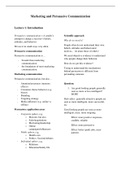Marketing and Persuasive Communication
Lecture 1: Introduction
Persuasive communication = A sender’s Scientific approach
attempt to change a receiver’s beliefs,
Why do we need it?
attitudes, and behavior
People often do not understand their own
We use it in small ways very often.
beliefs, attitudes and behavioural
Persuasive communication motives… let alone those of others!
Persuasive communication is… We need objective evidence to understand
why people change their behavior.
- broader than marketing
communication How do we get this evidence?
- the foundation of most marketing
Trying to understand the mechanisms
communication.
behind persuasion is different from
Marketing communication persuading someone.
Persuasive communication, but also…
- Attention/awareness (memory Question:
effects)
1. Are good-looking people generally
- Consumer choice behavior (e.g.
seen as more or less intelligent?
biases)
MORE
- Branding
- Targeting strategy Halo-effect: generally attractive people are
- Media influence (e.g. online vs seen as more intelligent, more successful,
offline) etc
Persuasion: application areas Good looking people are seen as more
intelligent, nicer, more outgoing
- Corporate sphere, e.g.
o Marcom, but also Effect: more positive responses,
o Sales/negotiations credible, reliable
o Motivating/leadership
o Online Effect: more persuasive
campaigns/influencers Effect: better (paid) jobs, nicer
- Public sphere, e.g. partners
o Health com
o Politics. Societal debates
- Individual sphere, e.g.
o Relations
o Education/family life
, 2. What is more effective in a TV
commercial?
- Arguments
- Images
- It depends on the person
- It depends on the product
3. Can it be effective to ‘flash’ secret Precise definition of Persuasion
messages for a few milliseconds
during a TV-commercial? … a symbolic process in which
- No communicators try to convince other
- Yes person to change their attitudes or
- Only if the message appeals to behaviour regarding an issue through the
receivers transmission of a message, in an
- Only if the message is displayed atmosphere of free choice.
long enough to be read
4. What would be a good time to
show a puppy in a tv-commercial?
- Right before showing the brand
- Right after showing the brand
- It depends on the product
- Any time
Conditioning effect
5. Which TV-commercial is
remembered best?
- The first of a commercial break
- The last of a commercial break
- The middle one
- The first and last one
6. Does a TV-commercial become
more effective if we ‘bob’ our
heads on the commercial’s music?
- Yes, because that means we like the
music
- Yes, because that means we are
really immersed in the commercial
- Yes, because we nod our heads
- No
It’s like saying ‘yes’ to yourself
,Lecture 2: Attitude & Balance Key characteristics of attitudes:
- Tendency: longer than emotions,
Try: attempt to convince shorter than personality trait
- Learned: through experience or
News may influence attitudes, but there other
usually is no ‘persuasive intent.’ - Evaluative: has a valence
If there is persuasive intent → persuasion (positive/negative) and intensity
(weak/strong)
- Directed at object: person, issue,
Atmosphere of free choice: group, etc
In case of unequal power/hierarchical
context there is no free choice (army) Attitudes functions
Hence: no persuasive communication Attitudes are (psychologically) useful
There is a difference between Why?
commanding/coercing and persuading.
There has to be a choice (hence free will) Katz (1960): ego-defensive, value-
for persuasion to occur. expressive, instrumental and knowledge
function
- Smith, Burner & White (1956):
Attitudes social adjustive function
‘A psychological tendency that is Knowledge function:
expressed by evaluating s particular entity
with some degree of favor or disfavor’ - Attitudes organize our thinking;
(Eagly & Chaiken, 1993) make the world
(Compared to the other definitions, this is understandable/predictable
not about objects, but it can also be about - Attitudes help us predict how people
situations) will respond/situation will work out
- e.g. good guys vs bad guys
Some degree/in favor or against
Instrumental function:
Object as in stuff
Object as in object of the course - attitudes and associated behavior
(approach: avoid) will help
Attitude is in your mind, not in ours. obtaining positive outcomes
Predisposition: it there before the object is (cleaning your room, working)
there. Predictable response to objects - usually result from learning
processes (rewards and
punishments); e.g. children develop
positive attitudes based on
associated positive outcomes
, Ego-defensive function: - Certainty of belief
‘Is he a bit unhinged or does he just
- attitudes help maintain a positive
have a lot of self confidence…?’
self-image
- Uniqueness of belief
- in- vs outgroup: negative attitudes
‘Kim Kardashian’s husband’
toward other groups confirms own
- Relative importance of belief
superiority
‘I don’t care about his private life’
- e.g. negative attitudes toward
immigrants Measuring attitudes
Value-expressive function: Good/bad
Positive/negative
- people want to express their identity
Pleasant/unpleasant
- attitudes help to express central
values, obtain social approval The multiple questions measuring the same
- e.g. liking classical music to show thing is to look at inter-item reliability
refinement, class
More complex possible
o e.g. loving ‘Black Pete’ (or
being woke?) More on attitudes in book:
Social adjustment - Nature of attitudes
- Values vs attitudes vs beliefs
- People like others with similar
- Prescriptive vs descriptive beliefs
beliefs
- Expressing attitudes helps in
forming or maintain (or blocking!)
relationships
o ‘wow, this class really
sucks, right?’
o ‘No, I think it’s the best
class ever!’
Always disagree is not always good,
people don’t like you then.
Expectancy-value approach (Fishbein &
Ajzen, 1975)
- Attitude = strength of beliefs X
evaluations of these beliefs
Strength of beliefs: KANYE WEST
- Accessibility: ‘ran for president’
- Personal importance of belief: ‘I
don’t like arrogant people’
- Personal importance of attitude
object: ‘since I was a kid, I learned
all his songs by heart’





